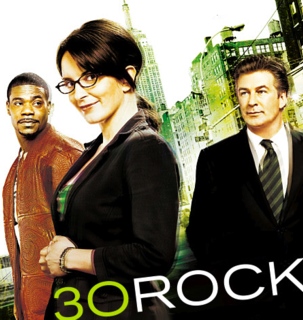Free Television
Lately, I have surprised myself by watching more television programs online. As a long time film buff and child of television, I like a big screen. I decried watching video on small devices like mobile devices. Lawrence of Arabia on an iPhone? Ridiculous.

My son gave me the first two seasons of 30 Rock on DVD for Christmas. He was surprised that I had never watched it and just knew I would like it. He was right. I have consuming episodes in small portions (not a 30 Rock marathon weekend which is just more of what is wrong with American consumption). I had avoided watching the current season because I wanted to catch up in the story arcs. Then I discovered that new episodes are available on Hulu.com.
What Hulu offers won't be a substitute for those DVDs, and it can only include "up to five trailing episodes of the current season for a limited time." What I'm using the service for is catching up on missed episodes. If I was more media-crazed at home, I could set things up to show them on a bigger screen than my laptop, but I have surprised myself. I'm okay with watching it on the laptop. 30 Rock is not Lawrence of Arabia and that's part of it.
Hulu also offers other shows past and present. I can even set up a queue that will save and remind me of episodes that are available. So, there's House and Fringe, but I also found classics that I loved like The Mary Tyler Moore Show and The Dick Van Dyke Show, and shows that might not be classics but that I'm curious to revisit (Night Gallery and Time Tunnel) or that people keep telling me to try (It's Always Sunny in Philadelphia).
 Hulu also offers clips and other content (like tonight's first address to Congress by President Obama) and I can also embed many of the offerings.
Hulu also offers clips and other content (like tonight's first address to Congress by President Obama) and I can also embed many of the offerings.
TV.com is another big site. Hulu.com recently pulled its videos from TV.com and is removing their content from another site called Boxee. CNet owns TV.com and it was pretty boring when I first looked at it. But CBS bought CNet last year, and the site is turning into a Hulu type of video portal.
So, Hulu was early to start and seems to have more streaming videos from more shows, but the competitors are lining up. TV.com seems to be moving towards more emphasis on the social aspects of watching online videos as a way to distinguish their service. Of course, networks also offer some of this content on their own sites.
There is money to be made through advertising, though it certainly isn't what these networks are used to getting. According to AdAge, TV.com was getting 10% of the ad revenue from views that originated from TV.com and can probably negotiate its own content deals now.

 I started teaching in the 1970's in a junior high school. I taught English and a course called "Film & Video." The latter was a course that was half film appreciation and half film/video production.
I started teaching in the 1970's in a junior high school. I taught English and a course called "Film & Video." The latter was a course that was half film appreciation and half film/video production. We used the Super 8 film cameras to make two minute (one roll of film) animated films.
We used the Super 8 film cameras to make two minute (one roll of film) animated films.  If you were a teacher in that period from the 60s through most of the 1980s, you just had to know how to thread a 16mm projector and fix a loop to get past torn sprockets. Kids who would have been computer nerds if there were computers were on the AVA squad (audio visual aids) delivering and fixing projectors, record players, overhead and filmstrip projectors and cassette recorders.
If you were a teacher in that period from the 60s through most of the 1980s, you just had to know how to thread a 16mm projector and fix a loop to get past torn sprockets. Kids who would have been computer nerds if there were computers were on the AVA squad (audio visual aids) delivering and fixing projectors, record players, overhead and filmstrip projectors and cassette recorders.